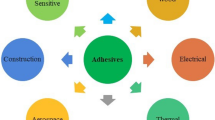Abstract
A hyperbranched epoxy resin has been synthesized by using epichlorohydrin, bisphenol-A, and hyperbranched polyether polyol by a low-temperature polycondensation technique in the presence of a base. The reaction parameters of this polycondensation reaction were optimized, and 5 N aqueous sodium hydroxide solution, (54 ± 1) °C reaction temperature and 3 h reaction time were found to be the best. The degree of branching of the resin was found to be 0.57 as determined from 13C nuclear magnetic resonance spectroscopy (Fig. 3). This hyperbranched epoxy resin was cured with poly(amido amine) hardener at 120 °C for a specified period of time. The resin exhibits very good crosscut adhesive strength (100%). The cured films showed moderate impact strength (60 cm), good scratch resistance (5.5 kg), good gloss (82 at 60°), thermostability up to 270 °C, and good chemical resistance in various chemical media. All these results indicate its suitability to be used as an advanced surface coating material.










Similar content being viewed by others
References
Y.H. Kim: Hyperbranched polymers 10 years after. J Polym. Sci. Part A: Polym. Chem. 36, 1685 (1998).
B. Voit: New developments in hyperbranched polymers. J Polym. Sci. Part A: Polym. Chem. 38, 2505 (2000).
B. Voit: Hyperbranched polymers: A chance and a challenge. C.R. Chim. 6, 821 (2003).
C. Gao and D. Yan: Hyperbranched polymers: From synthesis to applications. Prog. Polym. Sci. 29, 183 (2004).
S.S. Mahapatra and N. Karak: Hyperbranched polyamine: A promising curing agent for a vegetable oil-based poly(ester-amide) resin. Prog. Org. Coat. 60, 328 (2007).
M. Selvaraj, K. Maruthan, S. Palraj, and G. Venkatachari: Preparation and characterization of thermally stable epoxy-titanate coatings. Prog. Org. Coat. 67, 339 (2010).
R.J Gaier, W.C. Hardebeck, J.R. Terry Bunch, M.L. Davidson, and D.B. Beery: Effect of intercalation in graphite epoxy composites on the shielding of high energy radiation. J. Mater. Res. 13, 2297 (1998).
G. Possart, M. Presser, S. Passlack, P.L. Geiß, M. Kopnarski, A. Brodyanski, and P. Steinmann: Micro-macro characterisation of DGEBA-based epoxies as a preliminary to polymer interphase modelling. Int. J. Adhes. Adhes. 29, 478 (2009).
J-F. Fu, L-Y. Shi, S. Yuan, Q-D. Zhong, D-S. Zhang, Y. Chen, and J. Wu: Morphology, toughness mechanism, and thermal properties of hyperbranched epoxy modified diglycidyl ether of bisphenol A (DGEBA) interpenetrating polymer networks. Polym. Adv. Technol. 19, 1597 (2008).
R.S. Bouer: Epoxy Resin Chemistry (Am. Chem. Soc. Symp. Series no. 114, Washington DC, 1979).
˘.F. Mustata and I. Bicu: Multifunctional epoxy resins: Synthesis and characterization. J. Appl. Polym. Sci. 77, 2430 (2000).
Y.W. Chen-Yang, W.S. Wang, J.C. Tang, Y.W. Wu, and H.S. Chen: Novel flame retardant epoxy/clay nanocomposites prepared with a pre-ground phosphorus containing organoclay. J. Mater. Res. 23, 1618 (2008).
D. Zhang and D. Jia: Synthesis of novel low-viscosity liquid epoxidized aromatic hyperbranched polymers. Eur. Polym. J. 42, 711 (2006).
G. Das and N. Karak: Thermostable and flame retardant Mesua ferrea L. seed oil based non-halogenated epoxy resin/clay nanocomposites. Prog. Org. Coat. 69, 495 (2010).
G. Das and N. Karak: Mesua ferrea L. seed oil-based epoxy resins. J. Appl. Polym. Sci. 118, 128 (2010).
Y. Ishida, K. Yokomachi, M. Seino, T. Hayakawa, and M. Kakimoto: Synthesis, end-functionalization and characterization of hyperbranched polysiloxysilanes from AB3 type monomer. Macromol. Res. 15, 147 (2007).
N. Karak, B. Roy, and B. Voit: S-Triazine-based hyperbranched polyethers: Synthesis, characterization, and properties. J. Polym. Sci., Part A: Polym. Chem. 48, 3994 (2010).
S. Bhuniya and S. Maiti: Heterocyclic-based epoxy-terminated structural adhesive. II. Curing, adhesive strength, and thermal stability. J. Appl. Polym. Sci. 86, 3520 (2002).
A.M. Motawie, M.H. Sherif, M.M. Badr, A.A. Amer, and A.S. Shehat: Synthesis and characterization of waterborne epoxy resins for coating application. Aust. J. Basic Appl. Sci. 4, 1376 (2010).
D. Zhang, D. Jia, and Z. Zhou: Synthesis and characterization of low viscosity aromatic hyperbranched polyester epoxy resin. Macromol. Res. 17, 289 (2009).
V. Coessens, J. Pyun, P.J. Miller, S.G. Gaynor, and K. Matyjaszewski: Functionalization of polymers prepared by ATRP using radical addition reactions. Macromol. Rapid Commun. 21, 103 (2000).
C. Gong and J.M.J. Fre’chet: Proton transfer polymerization in the preparation of hyperbranched polyesters with epoxide chain-ends and internal hydroxyl functionalities. Macromolecules 33, 4997 (2000).
T. Emrick H.T. Chang, and J.M.J. Fre’chet: The preparation of hyperbranched aromatic and aliphatic polyether epoxies by chloride-catalyzed proton transfer polymerization from ABn and A2 + B3 monomers. J. Polym. Sci., Part A: Polym. Chem. 38, 4850 (2000).
O. Pascu, R. Garcia-Valls, and M. Giamberini: Interfacial polymerization of an epoxy resin and carboxylic acids for the synthesis of microcapsules. Polym. Int. 57, 995 (2008).
T. Emrick, H.T. Chang, J.M.J. Fréchet, J. Woods, and L. Baccei: Hyperbranched aromatic epoxides in the design of adhesive materials. Polym. Bull. 45, 1 (2000).
Acknowledgments
One of the authors, Buddhadeb Roy expresses his sincere gratitude to University Grant Commission (UGC), Delhi (India), for the financial assistance as Rajib Gandhi National Fellowship (RGNF). The author also thanks Central Instrumentation Facility, Tezpur University, India, for help in analysis and testing of the samples. The authors express their sincere thanks for departmental financial assistance to the SAP (UGC) New Delhi, India, through grant No. F.3-30/2009 (SAP-11) and Fund for Improvement of Science & Technology Infrastructure (FIST) program 2009, DST New Delhi, India, through Grant No. SR/FST/CSI-203/209/1.
Author information
Authors and Affiliations
Corresponding author
Rights and permissions
About this article
Cite this article
Roy, B., Karak, N. Synthesis and characterization of thermostable hyperbranched epoxy resin for surface coating applications. Journal of Materials Research 27, 1806–1814 (2012). https://doi.org/10.1557/jmr.2012.86
Received:
Accepted:
Published:
Issue Date:
DOI: https://doi.org/10.1557/jmr.2012.86




